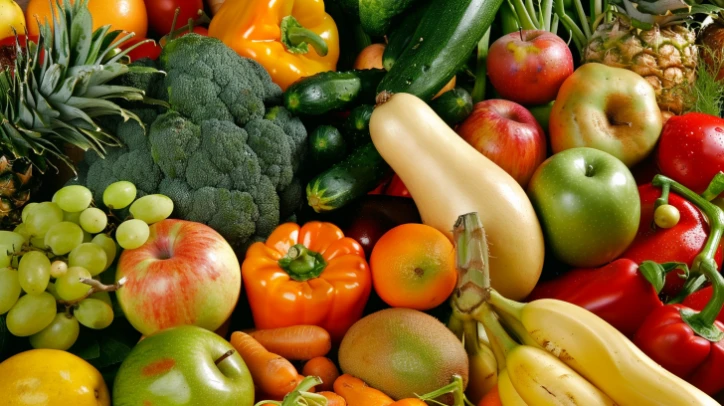Introduction: Overview of Yoga Diet and Nutrition
A yoga diet is fundamental to enhancing the practice of yoga, intertwining the benefits of physical, mental, and spiritual health. This approach to nutrition is not merely about what we eat but also how we eat and why we choose certain foods. By adopting a holistic diet, yogis can achieve greater wellness, balance, harmony, vitality, and mindfulness daily.
Yoga Diet Guide: Nutrition for Yogis
The connection between yoga and nutrition is profound. The foods we consume fuel our bodies, clear our minds, and uplift our spirits, directly influencing our yoga practice. A mindful eating approach ensures that every meal supports our physical strength, mental clarity, and spiritual growth.
Holistic Health: The Core of Yoga and Nutrition
Holistic health emphasizes the importance of viewing the body, mind, and spirit as an interconnected whole. A balanced yoga diet includes nutrient-dense foods that promote overall health. This diet typically features fresh, organic, and minimally processed foods, essential for maintaining energy levels and enhancing the body’s natural healing processes. For those undergoing yoga teacher training, understanding the connection between holistic health and nutrition is vital, as it equips them with the knowledge to guide their students effectively. Embracing a holistic diet supports both personal practice and the ability to teach yoga with a comprehensive understanding of its benefits.
Achieving Wellness Through Mindful Eating
Mindful eating, a vital component of a yoga diet, involves being fully present during meals, savouring each bite, and acknowledging the nourishment provided. This practice aligns perfectly with yoga’s principles, encouraging a deeper connection between food choices and overall well-being.

Principles of a Yoga Diet
A yoga-centric diet is grounded in three core principles: Ahimsa (non-violence), Sattva (purity), and Prana (life force). These principles guide dietary choices that support ethical eating, enhance physical and mental health, and promote spiritual growth.
Ahimsa: Non-Violence in Dietary Choices
Ahimsa, meaning non-violence, is a fundamental principle of yoga that extends to dietary habits. Practising Ahimsa through diet involves choosing foods that do not harm animals or the environment. This typically translates to a vegetarian or vegan diet, emphasizing plant-based foods. Ethical eating not only fosters compassion towards all living beings but also supports a sustainable and humane approach to nutrition.
Sattva: Embracing Purity in Food
Sattva represents purity and clarity, both in mind and body. A Sattvic diet includes foods that are fresh, natural, and minimally processed. These foods are believed to enhance mental clarity, calm the mind, and promote overall well-being. Sattvic foods include fresh fruits and vegetables, whole grains, nuts, seeds, and legumes. Avoiding stimulants, heavy spices, and overly processed foods is crucial to maintaining the purity and balance that Sattva embodies.
Prana: Nourishing Life Force Through Food
Prana, the life force, is vital energy in all living things. Prana-rich foods are considered highly beneficial as they energize the body and mind. Pranic foods are fresh, organic, and alive with natural energy. These include fresh fruits, vegetables, sprouts, and herbs. Consuming Pranic foods helps maintain high energy levels, supports mental clarity, and enhances overall vitality.
Ethical Nutrition and Clean Eating
Integrating these principles into your diet means adopting practices of ethical nutrition and clean eating. By focusing on plant-based, non-harming foods and avoiding processed items, you align your dietary choices with the core values of yoga. This approach not only benefits personal health but also contributes positively to the environment and society.
Understanding the Yoga Diet Philosophy
The philosophy of a yoga diet is deeply intertwined with the ethical guidelines outlined in yoga’s foundational texts, particularly the yamas and niyamas. These guidelines, described in Patanjali’s Yoga Sutras, provide a framework for living a life of integrity, mindfulness, and spiritual growth. Understanding these principles can help yogis make dietary choices that align with their practice.
Yamas and Niyamas: The Ethical Foundation
The yamas and niyamas are the first two limbs of the Eight Limbs of Yoga described by Patanjali. They serve as ethical precepts and personal observances, guiding yogis in interacting with the world and themselves. These principles extend beyond the mat and into all aspects of life, including diet.
Yamas: Ethical Guidelines
The yamas are five ethical guidelines that promote harmony in our interactions with others and the environment:
- Ahimsa (Non-Violence): Beyond physical actions to include dietary choices, Ahimsa encourages a diet that avoids harm to living beings, promoting vegetarianism or veganism.
- Satya (Truthfulness): Choosing foods that are pure and unadulterated, supporting honesty in what we consume.
- Asteya (Non-Stealing): Mindful consumption and avoiding waste, ensuring resources are shared fairly.
- Brahmacharya (Moderation): Practicing moderation in eating, and avoiding overindulgence to maintain balance.
- Aparigraha (Non-Possessiveness): Encouraging simplicity in diet, avoiding excessive accumulation of food and material goods.
Niyamas: Personal Observances
The niyamas are five personal observances that guide self-discipline and spiritual growth:
- Saucha (Cleanliness): Emphasizing clean eating with foods that are pure and unprocessed, promoting physical and mental clarity.
- Santosha (Contentment): Finding satisfaction with simple, wholesome foods, fostering gratitude and mindfulness.
- Tapas (Discipline): Applying discipline in dietary habits, such as regular meals and mindful eating practices.
- Svadhyaya (Self-Study): Reflecting on how food choices affect our body, mind, and spirit, encouraging self-awareness.
- Ishvara Pranidhana (Surrender to a Higher Power): Recognizing the sacredness of food and its role in sustaining life, approaching meals with reverence and gratitude.
Holistic Eating and Spiritual Nutrition
A yoga diet philosophy encourages holistic eating, which considers the impact of food on the body, mind, and spirit. It promotes spiritual nutrition by selecting foods that support mindfulness, gratitude, and spiritual practice. This approach aligns dietary choices with the ethical teachings of yoga, fostering a deeper connection between what we eat and our overall well-being.
Benefits of a Plant-Based Yoga Diet
Adopting a plant-based diet offers numerous advantages for yoga practitioners. This dietary approach aligns with the principles of yoga, enhancing physical health, mental clarity, and overall well-being. Here, we explore the key benefits of a plant-based diet for those engaged in yoga practice.
Enhanced Energy Levels
A plant-based diet provides sustained energy levels essential for a rigorous yoga practice. Foods rich in complex carbohydrates, such as whole grains, legumes, and vegetables, release energy slowly, ensuring a steady supply throughout the day. This sustained energy helps yogis maintain endurance and stamina during their practice.
Improved Digestion
Plant-based diets are high in dietary fibre, which aids in digestion and promotes regular bowel movements. Foods such as fruits, vegetables, whole grains, and legumes support a healthy digestive system, reducing bloating and discomfort. Better digestion also ensures the body efficiently absorbs essential nutrients, enhancing overall health.
Mental Clarity
Consuming plant-based foods rich in antioxidants, vitamins, and minerals supports brain health and improves mental clarity. Nutrients in leafy greens, berries, nuts, and seeds help reduce oxidative stress and inflammation, promoting cognitive function and concentration. A clear mind is vital for maintaining focus during yoga practice and meditation.
Health Benefits
A plant-based diet offers numerous health benefits, including reduced risk of chronic diseases. Research has shown that plant-based nutrition can lower the incidence of heart disease, hypertension, diabetes, and certain cancers. These health benefits are attributed to the anti-inflammatory properties of plant-based foods and their high content of essential vitamins and minerals.
Essential Nutrients in a Plant-Based Diet
- Fiber: Essential for digestive health and maintaining a healthy weight.
- Antioxidants: In fruits and vegetables, antioxidants protect cells from damage and support immune function.
- Vitamins and Minerals: Crucial for overall health, including vitamin C for immune support, vitamin E for skin health, and magnesium for muscle function.
Yoga and Plant-Based Nutrition
Integrating plant-based nutrition into your yoga practice can enhance your overall experience. By choosing nutrient-dense, whole foods, you support your body’s physical needs and create a foundation for mental and spiritual growth. This dietary approach promotes harmony and balance, core tenets of both yoga and holistic health. Whether you’re performing asana yoga or meditating, a well-balanced diet helps maintain the energy and focus needed for these practices.
Foods to Eat and Avoid for Yoga Practitioners
Choosing the right foods is essential for optimizing your yoga practice. A yoga diet emphasizes Sattvic foods, as well as organic and whole foods while avoiding processed and spicy foods. This section outlines the best foods for yoga practitioners and those to avoid for maintaining purity, balance, and optimal digestion.
Recommended Sattvic Foods
Sattvic foods are pure, natural, and unprocessed, promoting clarity, calmness, and spiritual growth. These foods are essential for maintaining a balanced and harmonious lifestyle. Here is a list of Sattvic foods that should be included in a yoga diet:
- Fresh Fruits and Vegetables: Apples, bananas, leafy greens, carrots, and cucumbers.
- Whole Grains: Brown rice, quinoa, oats, and barley.
- Nuts and Seeds: Almonds, sunflower seeds, sesame seeds, and flaxseeds.
- Legumes: Lentils, mung beans, chickpeas, and black beans.
- Dairy Products: Milk, ghee, and yoghurt (for dairy consumers).
- Herbs and Spices: Basil, turmeric, ginger, and cilantro.
- Natural Sweeteners: Honey and jaggery.
These foods are rich in nutrients, support digestion, and enhance mental clarity, making them ideal for yoga practitioners.
Emphasizing Organic and Whole Foods
Organic foods are free from harmful chemicals and pesticides, supporting overall health and well-being. Whole foods are minimally processed and retain their natural nutrients. Including organic and whole foods in your diet ensures that you consume pure and unadulterated nutrition, which is crucial for maintaining a healthy body and mind.
Foods to Avoid
Certain foods can negatively impact your yoga practice by causing physical discomfort, mental agitation, or disrupting spiritual focus. Here are some foods to avoid:
- Processed Foods: Packaged snacks, sugary cereals, and canned goods often contain additives and preservatives that can harm your health.
- Spicy Foods: Excessively spicy foods can cause indigestion and discomfort, distracting from your practice.
- Stimulants: Caffeine and alcohol can overstimulate the nervous system, reducing mental clarity and focus.
- Heavy or Oily Foods: Fried foods and those high in unhealthy fats can cause lethargy and sluggishness.
- Meat and Fish: These are considered Tamasic (inert) or Rajasic (stimulating) and can affect mental peace and clarity.
Yoga Nutrition Tips
To maximize the benefits of your yoga practice through diet, follow these yoga nutrition tips:
- Eat Mindfully: Pay attention to your food, chew slowly, and savour each bite.
- Stay Hydrated: Drink plenty of water and herbal teas to keep your body hydrated and support digestion.
- Regular Meal Times: Establish a meal routine to maintain balance and support digestive health.
- Portion Control: Eat moderate portions to avoid overeating and ensure comfort during practice.
Ayurvedic Nutrition
Ayurvedic nutrition plays a significant role in a yoga diet, offering guidelines to balance the body’s doshas through tailored dietary choices. Ayurveda, an ancient system of medicine from India, emphasizes harmony and balance by understanding individual body types and their elemental qualities. Integrating Ayurvedic principles into a yoga diet can enhance overall well-being and support a more effective yoga practice.
Understanding the Doshas
According to Ayurveda, each person has a unique constitution comprising three doshas: Vata, Pitta, and Kapha. These doshas represent different elemental qualities and govern various physiological and psychological bodily functions.
- Vata: Associated with air and space, Vata governs movement, including breathing and circulation. People with a dominant Vata dosha tend to be energetic and creative but may also experience anxiety and digestive issues when out of balance.
- Pitta: Linked to fire and water, Pitta controls digestion and metabolism. Those with a dominant Pitta dosha are typically ambitious and intelligent but may suffer from irritability and inflammation if imbalanced.
- Kapha: Connected to earth and water, Kapha is responsible for stability and structure in the body. Individuals with a dominant Kapha dosha are generally calm and loyal but can face issues like weight gain and lethargy when not in balance.
Balancing Doshas Through Diet
Ayurvedic nutrition recommends specific foods to balance each dosha, promoting harmony and optimal health. Here are the dietary guidelines for each dosha:
Vata-Balancing Diet
- Focus on: Warm, cooked foods; grounding grains like rice and oats; root vegetables; and hydrating fruits.
- Avoid: Cold, raw foods; caffeine; and excessive dry or crunchy foods.
- Examples: Steamed vegetables, soups, stews, and herbal teas.
Pitta-Balancing Diet
- Focus on: Cooling foods; sweet and bitter vegetables; high-water content fruits; and whole grains.
- Avoid: Spicy, oily, fried foods; excessive salt; and alcohol.
- Examples: Cucumbers, melons, leafy greens, and cooling herbs like mint and cilantro.
Kapha-Balancing Diet
- Focus on: Light, warm, and stimulating foods; plenty of vegetables; and legumes.
- Avoid: Heavy, oily, and sugary foods; dairy products; and excessive cold foods.
- Examples: Steamed broccoli, lentil soups, and spicy dishes with ginger and black pepper.
Integrating Ayurveda and Yoga
Combining Ayurvedic principles with a yoga diet enhances the benefits of both practices. A balanced Ayurvedic diet supports the body’s natural rhythms and aligns with the holistic approach of yoga, promoting overall wellness.
Ayurvedic Eating Guidelines
- Eat Fresh and Seasonal: Choose fresh, locally sourced foods in season to ensure optimal nutrient content.
- Mindful Eating: Practice mindfulness by eating slowly, savouring each bite, and avoiding distractions during meals.
- Regular Meal Times: Maintain consistent meal times for digestive health and metabolic efficiency.
- Tailored Nutrition: Adjust your diet according to your dosha, current health conditions, and seasonal changes.
Recipes and Meal Plans for Yoga Practitioners

Creating practical and healthy recipes is essential for yoga practitioners who aim to maintain a Sattvic diet and balance their doshas. This section provides easy and nutritious recipes, meal ideas that support detoxification, and meal plans tailored to balance Vata, Pitta, and Kapha doshas.
Sattvic Recipes
Sattvic meals are simple, fresh, and nourishing. They focus on purity and balance, promoting physical health and mental clarity.
- Oatmeal with Fresh Fruits and Nuts
- Ingredients:
- 1 cup rolled oats
- 2 cups water or almond milk
- 1 apple, diced
- 1 banana, sliced
- 1/4 cup almonds or walnuts
- 1 tsp honey
- 1/2 tsp cinnamon
- Instructions:
- Cook oats in water or almond milk over medium heat until soft.
- Add diced apple and banana.
- Top with nuts, honey, and cinnamon before serving.
- Ingredients:
- Quinoa Salad with Vegetables
- Ingredients:
- 1 cup quinoa, rinsed
- 2 cups water
- 1 cucumber, diced
- 1 bell pepper, diced
- 1 cup cherry tomatoes, halved
- 1/4 cup fresh parsley, chopped
- 2 tbsp olive oil
- 1 lemon, juiced
- Salt and pepper to taste
- Instructions:
- Cook quinoa in water until fluffy.
- Combine quinoa with vegetables and parsley.
- Drizzle with olive oil and lemon juice.
- Season with salt and pepper.
- Ingredients:
Detoxifying Foods
Detox foods help cleanse the body and promote overall health. Incorporate these foods into your diet for regular detoxification:
- Green Smoothie
- Ingredients:
- 1 cup spinach
- 1/2 cucumber
- 1 green apple
- 1/2 lemon, juiced
- 1-inch piece of ginger
- 1 cup water
- Instructions:
- Blend all ingredients until smooth.
- Serve immediately for a refreshing detox drink.
- Ingredients:
- Lentil Soup
- Ingredients:
- 1 cup lentils, rinsed
- 4 cups vegetable broth
- 1 carrot, diced
- 1 celery stalk, diced
- 1 onion, chopped
- 2 cloves garlic, minced
- 1 tsp turmeric
- 1 tsp cumin
- Salt and pepper to taste
- Instructions:
- Sauté onion, garlic, carrot, and celery in a pot until soft.
- Add lentils, broth, and spices.
- Simmer until lentils are tender.
- Season with salt and pepper before serving.
- Ingredients:
Meal Plans for Balancing Doshas
Creating meal plans that balance the doshas can help maintain harmony in the body and mind.
Vata-Balancing Meal Plan
- Breakfast: Warm oatmeal with apples and nuts.
- Lunch: Quinoa salad with steamed vegetables.
- Dinner: Lentil soup with root vegetables.
- Snacks: Fresh fruit and herbal teas.
Pitta-Balancing Meal Plan
- Breakfast: Green smoothie with spinach and apple.
- Lunch: Cucumber and mint quinoa salad.
- Dinner: Stir-fried tofu with broccoli and bell peppers.
- Snacks: Fresh melon and coconut water.
Kapha-Balancing Meal Plan
- Breakfast: Spiced chai tea and fruit salad.
- Lunch: Lentil soup with a side of steamed greens.
- Dinner: Baked vegetables with quinoa.
- Snacks: Apple slices with cinnamon and ginger tea.
The Impact of Diet on Yoga Practice
A well-balanced diet significantly influences yoga performance and overall practice. Proper nutrition enhances flexibility, strength, mental clarity, and energy levels, which are crucial for a practical and fulfilling yoga experience. Understanding how diet affects these aspects can help yogis optimize their practice and achieve better results.
Flexibility and Diet
Flexibility is a critical component of yoga practice, allowing for a broader range of motion and the ability to perform various poses effectively. Certain nutrients play a vital role in maintaining and improving flexibility:
- Hydration: Staying well-hydrated is essential for keeping muscles and joints supple. Water-rich foods like cucumbers, melons, and leafy greens contribute to hydration.
- Omega-3 Fatty Acids: In flaxseeds, walnuts, and chia seeds, omega-3 fatty acids help reduce inflammation and support joint health, enhancing flexibility.
- Magnesium: This mineral, present in foods like almonds, spinach, and avocados, helps relax muscles and prevent cramps, contributing to better flexibility.
Strength and Diet
Strength is necessary for performing yoga poses with stability and control. A diet rich in the following nutrients supports muscle strength and development, which are crucial for effective yoga practice and understanding yoga anatomy:
- Protein: Essential for muscle repair and growth, protein can be found in plant-based sources such as lentils, chickpeas, tofu, and quinoa.
- Iron: Crucial for energy production and muscle function, iron-rich foods include spinach, lentils, and fortified cereals.
- Vitamin D and Calcium: These nutrients, found in fortified plant milk, leafy greens, and almonds, support bone health and muscle function.
Mental Clarity and Diet
Mental clarity enhances focus and concentration during yoga practice. The right foods can improve cognitive function and support a calm, clear mind:
- Antioxidants: Berries, nuts, and dark chocolate are rich in antioxidants, which protect the brain from oxidative stress and improve cognitive function.
- Healthy Fats: Omega-3 fatty acids in flaxseeds and walnuts support brain health and mental clarity.
- B Vitamins: Found in whole grains, legumes, and leafy greens, B vitamins play a crucial role in brain function and energy production.
These nutrients are particularly beneficial for practices like pranayama, where mental clarity and focus are essential for effective breath control and meditation.
Energy and Diet
Sustained energy is vital for maintaining endurance and stamina during yoga practice. Nutrient-dense foods provide long-lasting energy and prevent fatigue:
- Complex Carbohydrates: Whole grains, sweet potatoes, and legumes provide slow-releasing energy, keeping you fueled throughout your practice.
- Fruits and Vegetables: These foods are packed with vitamins, minerals, and natural sugars, offering a quick energy boost while supporting overall health.
- Balanced Meals: Combining carbohydrates, proteins, and fats in each meal helps maintain steady energy levels and prevents energy crashes.
Yoga Performance and Nutrition
The relationship between diet and yoga performance is profound. A balanced diet not only supports physical aspects like flexibility and strength but also enhances mental clarity and energy levels, leading to a more effective and enjoyable yoga practice. By focusing on nutrient-dense foods that promote overall health, yogis can optimize their performance and achieve their wellness goals.
Conclusion: Yoga Diet and Nutrition
A yoga diet emphasizing principles like Ahimsa (non-violence), Sattva (purity), and Prana (life force) profoundly enhances yoga practice by promoting physical, mental, and spiritual health. By integrating mindful eating and Ayurvedic guidelines to balance the doshas, yogis can achieve better flexibility, strength, mental clarity, and energy. This holistic approach involves consuming plant-based, organic, and whole foods while avoiding processed and spicy items, ensuring overall well-being and optimal yoga performance. Embracing these dietary practices supports a harmonious and balanced lifestyle, aligning nutrition with the core values of yoga.






